Planted Aquarium Blogs
Why Non CO2 Planted Tank is Perfect for Beginners in India
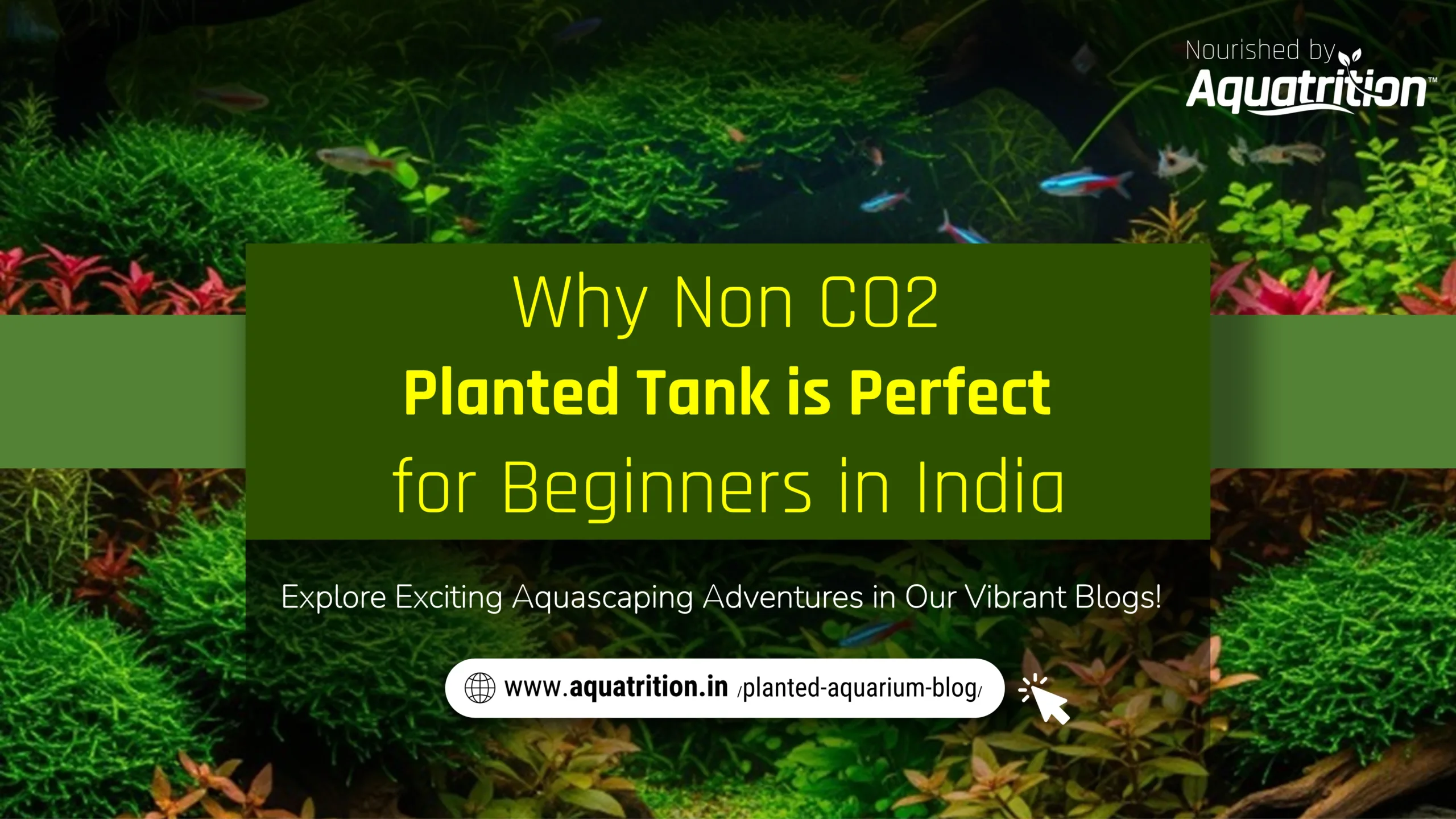
I. Introduction
Think planted tanks need expensive gear and CO₂ setups? Think again.
Heard about non CO2 planted tank?
If you’ve ever been fascinated by the beauty of lush, green underwater landscapes but felt intimidated by the idea of setting up CO₂ cylinders, diffusers, and regulators—you’re not alone. Many beginners assume that growing healthy aquarium plants automatically requires advanced equipment and constant monitoring. But the truth is, one can absolutely create a thriving planted aquarium without CO₂ injection.
Welcome to the world of non CO2 planted tank—a beginner-friendly, low-maintenance, and budget-conscious approach to aquascaping. These tanks rely on naturally available carbon dioxide (from fish respiration and organic breakdown) and are designed around slow-growing, hardy plant species that don’t demand high energy inputs.
In this blog, we’ll walk you through why non CO2 planted tank is perfect for beginners in India, the best plants to choose, how to fertilize effectively, and simple setup tips using Aquatrition’s trusted plant care solutions. Whether you’re starting your first nano tank or looking to keep things low-tech, this guide will help you grow green with confidence CO2-free.
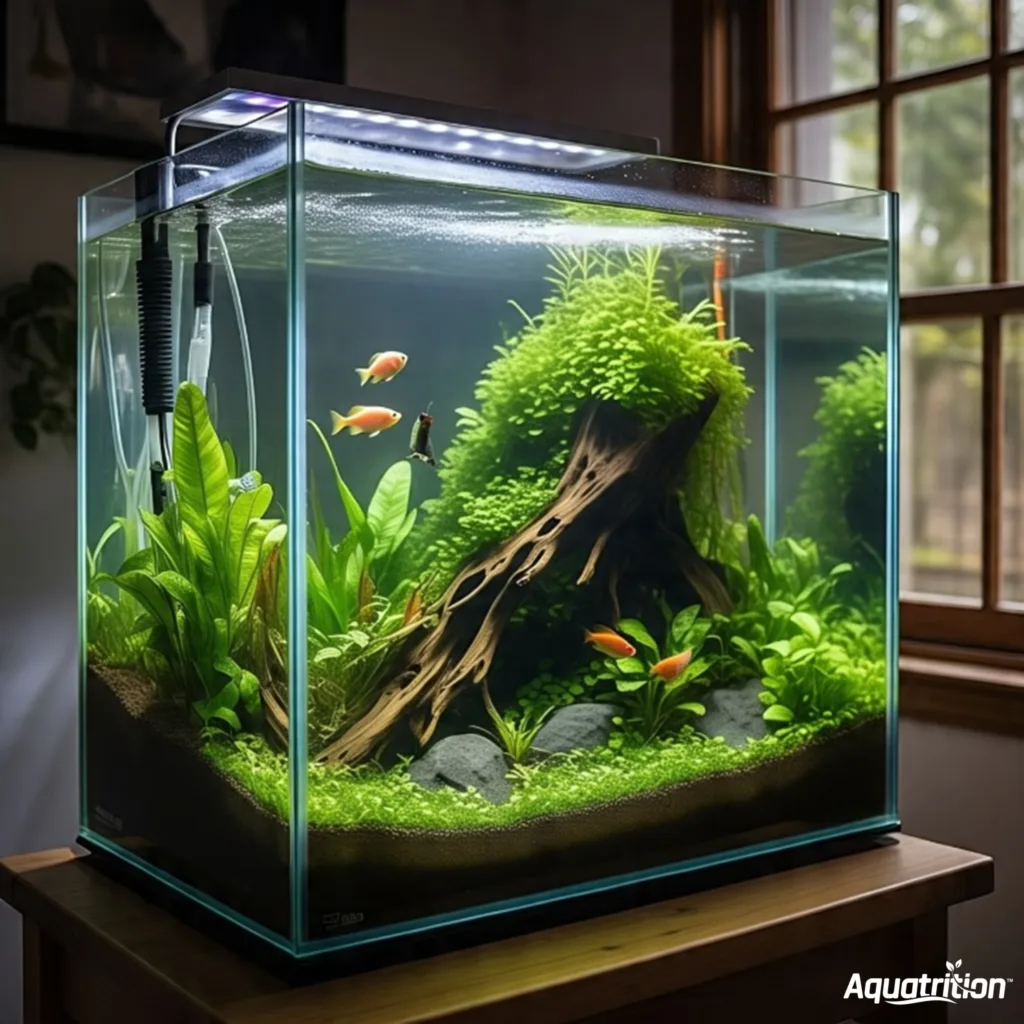
II. What Is a Non-CO₂ Planted Tank?
A non CO2 planted tank is an aquarium setup that supports the healthy growth of aquatic plants without using any pressurized CO₂ injection systems. Instead of relying on external CO₂ equipment, these tanks make use of naturally available CO₂, which comes from fish respiration, organic matter breakdown, and gas exchange at the water surface.
Natural CO₂ vs. Pressurized CO₂
- Natural CO₂:
In every aquarium, fish and other organisms naturally release carbon dioxide into the water as they breathe. In low-tech setups, this CO₂—although limited—is often enough to support slow-growing, hardy plant species when paired with proper lighting and nutrient dosing.
- Pressurized CO₂ Systems:
These setups involve CO₂ cylinders, regulators, diffusers, and bubble counters to inject concentrated CO₂ into the tank. While this approach boosts plant growth and allows for more demanding species, it also increases the cost, complexity, and maintenance involved.
Perfect for Low-Tech, Budget-Friendly Setups
Non CO2 planted tank is especially suited for:
- Beginners who want an easy start
- Budget-conscious hobbyists who want to avoid expensive gear
- Low-maintenance tanks in homes, offices, or small apartments
- Aquarists who prefer slow and steady plant growth with less frequent trimming
With the right balance of light, nutrients, and plant selection, a non-CO₂ tank can look just as beautiful as a high-tech aquascape – without the extra hassle.
III. Why Are Non-CO₂ Tanks Perfect for Indian Beginners?
Starting a planted aquarium can feel overwhelming especially with the technical jargon, costly gear, and conflicting advice online. But non CO2 planted tank offers a simple, low-risk entry point for beginners, particularly in India where home conditions and budgets vary widely. Here’s why they’re the ideal starting point:
1. Easy to Set Up and Maintain
One of the biggest perks of a non CO2 planted tank is how simple it is to start. One doesn’t need to invest in:
- Pressurized CO₂ cylinders
- Complex regulators
- Diffusers or bubble counters
Fewer components mean fewer things to install, monitor, or troubleshoot. Oner can focus on enjoying aquatic plants and fish instead of adjusting flow rates or checking bubble counts. It’s a hassle-free way to enter the planted aquarium world with confidence.

2. Cost-Effective
For many Indian hobbyists especially beginners or those just dipping their toes into the hobby – budget is a key factor. Non-CO₂ tanks cut down on:
- Initial setup costs
- Long-term maintenance expenses
By skipping CO₂ injection systems and sticking to hardy plants and affordable all-in-one aquarium plant fertilizers, one can create a beautiful aquascape without burning a hole in the pocket. It’s the perfect entry-level setup that doesn’t compromise on results.
3. Low Maintenance = Less Stress
CO2 injected tanks can demand fast trimming, daily dosing, and constant monitoring. In contrast, non-CO2 tanks grow at a slower, more manageable pace, which means:
- Less frequent pruning
- Lower risk of nutrient imbalances
- Minimal algae problems when your light and nutrients are balanced
This slower pace creates a more relaxed experience—ideal for beginners who want to learn and enjoy, not stress over maintenance.
4. Works in Indian Home Conditions
Indian tap water, ambient room temperatures, and average lighting setups are often well-suited for low-tech aquariums. Many non CO2 aquarium plants thrive in these conditions, making them easy to grow even in:
- Compact urban apartments
- Rental spaces
- Office desktops or waiting rooms
With basic tools and regular care, anyone in India can successfully maintain a thriving non-CO2 planted tank—even with limited space or time.
IV. Do You Still Need Fertilizer in a Non-CO2 Tank?
Yes—the aquatic plants still need nutrients, even without CO2 injection.
It’s a common misconception that skipping CO2 means skipping fertilizers too. But the truth is, while CO2 helps plants grow faster, fertilizers provide the essential nutrients that plants need to survive, grow, and stay healthy—no matter the setup.
Water Column vs. Root Feeders
In a planted aquarium, plants absorb nutrients in two main ways:
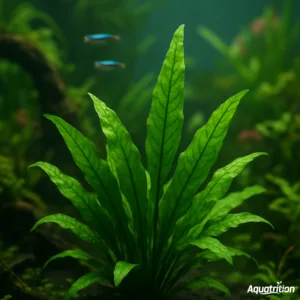
- Water Column Feeders: These plants take nutrients directly from the water through their leaves. Examples include Java Fern, Anubias, and floating plants. They benefit most from liquid fertilizers added to the tank water.
- Root Feeders: These plants absorb nutrients through their root systems. Examples include Amazon Swords, Cryptocorynes, and Vallisneria. They grow best with a nutrient-rich substrate or with liquid fertilizers combined with root tabs.
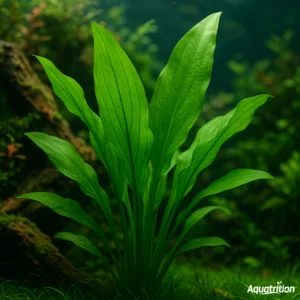
Whether you’re growing water-column or root feeders, fertilizer is still essential—especially in a non-CO2 tank where plant growth is slower and more dependent on consistent care.
V. Do’s and Don’ts of Non-CO2 Aquascaping
Building a successful non-CO2 planted aquarium is all about balance—between light, nutrients, and plant growth. Since we are not supplementing with pressurized CO2, every small decision has a big impact on your tank’s health and appearance.
Here are some simple do’s and don’ts to help your aquascape flourish without CO2 injection:
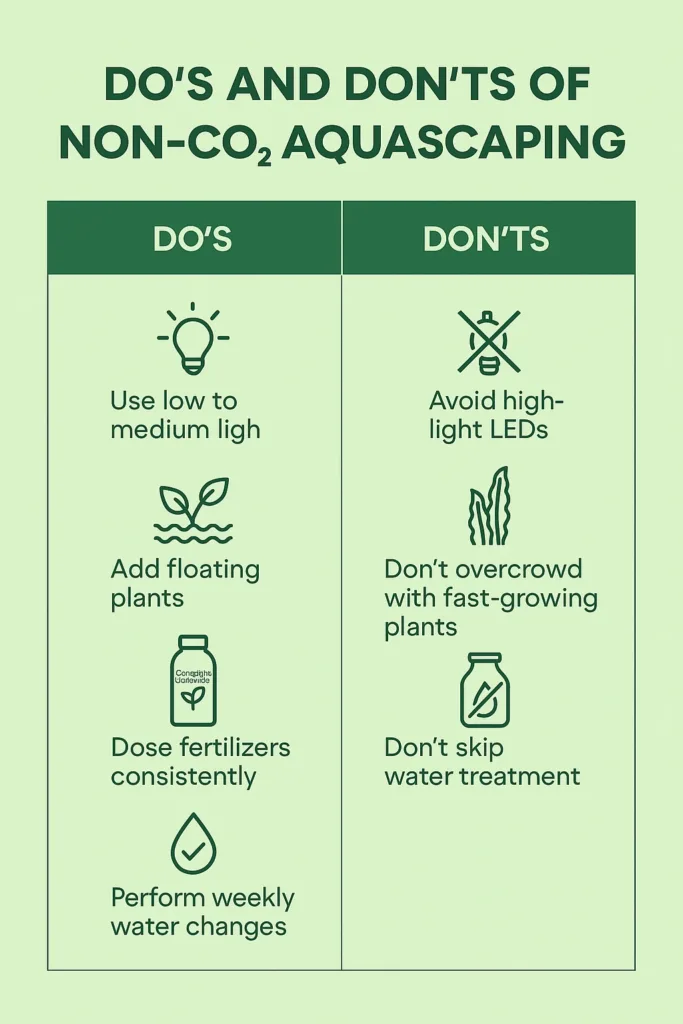
✅ Do’s and Don’ts of Non-CO₂ Aquascaping
Do’s | Don’ts |
Use low to medium light to prevent algae and promote balanced growth | Avoid high-light LEDs which can cause algae in the absence of CO₂ |
Add floating plants like Frogbit or Salvinia to reduce light intensity and absorb excess nutrients | Don’t overcrowd with fast-growing plants that may outcompete nutrients |
Dose fertilizers consistently atleast 2–3 times a week | Don’t skip water treatment – always use a chlorine remover for tap water |
Perform weekly water changes (20–30%) to maintain water quality and nutrient balance |
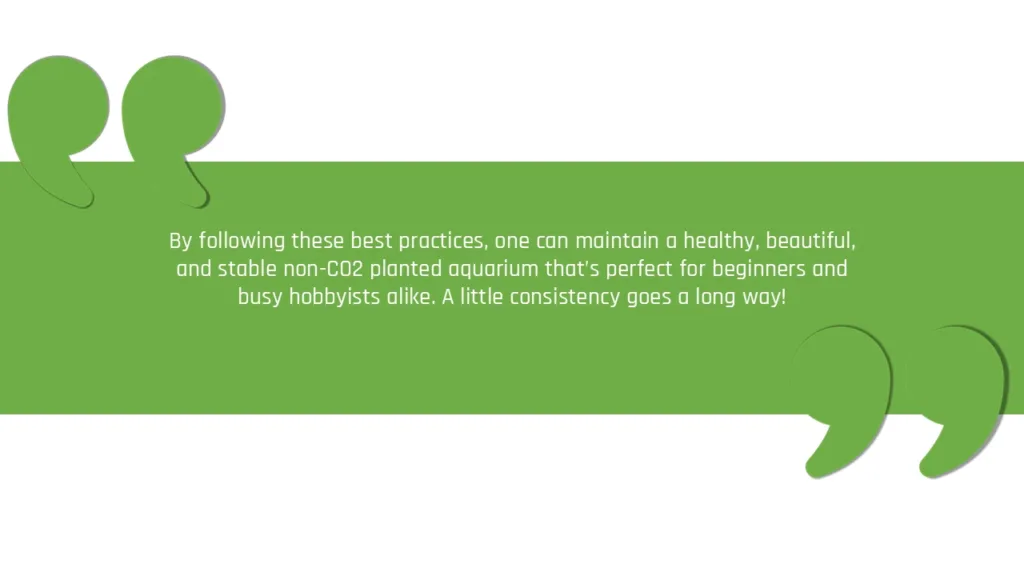
VI. Conclusion
Starting your journey into the world of planted aquariums doesn’t have to involve complicated CO2 systems or expensive equipment. As we’ve explored, non-CO2 planted tanks are the perfect entry point for beginners in India—offering a low-maintenance, budget-friendly, and highly rewarding way to enjoy aquascaping.
With the right combination of slow-growing plants, balanced lighting, and consistent fertilizer dosing, you can build a thriving underwater ecosystem using just the basics.
Products like Complete Nourishment and Liquid Carbon make it easy to maintain a healthy tank—even without pressurized CO2.
Explore our Comprehensive Guide to Aquatic Plants for plant care tips, species recommendations, and beginner setups that will help you grow confidently—one leaf at a time.
Frequently Asked Questions (FAQs)
Can aquarium plants grow without CO2 injection?
Yes! Many aquatic plants can thrive in a low-tech, non-CO2 environment by relying on the natural CO2 produced by fish and biological processes. You just need to choose slow-growing, hardy species and ensure they receive proper light and nutrients.
What are the best plants for a non-CO2 planted tank?
Beginner-friendly non-CO2 aquatic plants include:
- Anubias nana
- Java Fern
- Cryptocoryne wendtii
- Vallisneria spiralis
- Amazon Sword
- Java Moss
These plants grow slowly and do well in low to medium lighting without extra CO2.
Do I still need to use fertilizer in a non-CO2 tank?
Absolutely. Even without CO2 injection, plants need nutrients like nitrogen, phosphorus, potassium, and trace elements. Use an all-in-one aquarium fertilizer like Complete Nourishment to support healthy plant growth.
What is Liquid Carbon, and do I need it?
Liquid Carbon is a supplement that provides a readily available source of carbon for plants. While it doesn’t replace CO2 injection, it helps boost growth and control algae, making it a great option for low-tech tanks.
Can I use tap water for my non-CO2 aquarium?
Yes, but you should treat it with a chlorine remover to make it safe for fish and plants. Chlorine and chloramine in untreated tap water can harm beneficial bacteria and sensitive aquatic life.
How much light do I need for a non-CO2 planted tank?
Stick to low to medium intensity light, ideally LED lights made for planted tanks. Avoid high-intensity lights, which can cause algae issues if not balanced with CO2 and nutrients.
How often should I change the water in a non-CO2 planted tank?
A good rule of thumb is to change 20–30% of the tank water once a week. This helps control nutrient buildup, maintain water clarity, and prevent algae outbreaks.
Is a non-CO2 tank suitable for Indian homes and climates?
Yes! Non-CO2 tanks are perfect for Indian households. Most hardy plants thrive in ambient room temperatures and local tap water (once treated). They’re compact, easy to maintain, and ideal for apartments and office spaces.

Loved this! I’ve always been scared to go the CO2 route glad to know the alternate options.
Great read. Non CO2 tanks are underrated and this article proves it.